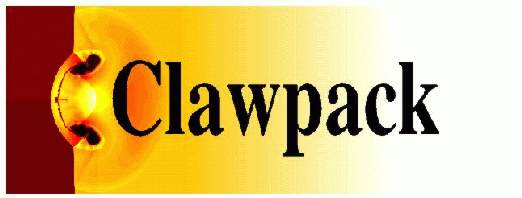|
plotframe1.m.html |
 |
|
Source file: plotframe1.m
|
|
Directory: /home/rjl/git/rjleveque/clawpack-4.x/matlab
|
|
Converted: Sun May 15 2011 at 19:15:58
using clawcode2html
|
|
This documentation file will
not reflect any later changes in the source file.
|
%
% PLOTFRAME1 plots data from a single Clawpack output file.
%
% PLOTFRAME1 is called from PLOTCLAW1, the driver script for Clawpack
% graphics. PLOTFRAME1 uses parameters, defined in the user's
% workspace, usually in the SETPLOT1 script, to determine what kind of
% plot to create, and various other plotting options.
%
% See SETPLOT for a complete list of the parameters that the user can
% set.
%
% The basic plot type available in 1d is a 1d line plot, with user
% specified symbols.
%
% By specifying MAPPEDGRID == 1, a user defined function mapc2p will be
% called
%
% See SETPLOT, PLOTCLAW1, MAPPEDGRID.
if length(amrdata) == 0
disp(' ');
disp(['Frame ',num2str(Frame),' does not exist ***']);
return;
end
disp(' ')
disp(['Frame ',num2str(Frame),' at time t = ',num2str(t)]);
if exist('beforeframe')==2
beforeframe % make an m-file with this name for any other commands you
% want executed before drawing each frame, for example
% if you want to use axes to specify exactly where the
% plot will be in the window, aspect ratio, etc.
end
set_value('maxlevels','MaxLevels',6);
if (~exist('PlotStyle') & exist('plotstyle'))
% Parse line spec style
disp([' *** plotframe1 : ''plotstyle'' should be replaced by ',...
'''PlotStyle''. Set SETPLOTSTYLE.']);
if (~iscell(plotstyle))
% This provides backwards compatibility for plots with a single type.
PlotStyle = {plotstyle};
else
PlotStyle = plotstyle;
end;
end;
set_value('pstyle','PlotStyle',{'b-'});
if (~iscell(PlotStyle))
error([' *** plotframe1 : PlotStyle must be a cell matrix. ',...
'Use ''setplotstyle''.']);
end;
[linestyle,linecolors,markerstyle] = get_plotstyle(pstyle,maxlevels);
set_value('mappedgrid','MappedGrid',0);
if (mappedgrid == 1)
if (~exist('mapc2p'))
error(' *** plotframe1 : MappedGrid == 1 but no mapc2p function was found');
end;
end;
clear_amrplot;
create_amrplot(maxlevels);
% Call to 'newplot' is needed in case the user has added any extra lines
% to the plot (in afterframe, for example), using 'hold on/off'. 'newplot'
% respects the hold on/off commands, whereas clear_amrplot and
% create_amrplot do not.
newplot;
%=============================================
% MAIN LOOP ON GRIDS FOR THIS FRAME:
%=============================================
qmin = [];
qmax = [];
for ng = 1:length(amrdata),
gridno = amrdata(ng).gridno;
level = amrdata(ng).level;
mx = amrdata(ng).mx;
xlow = amrdata(ng).xlow;
dx = amrdata(ng).dx;
data = amrdata(ng).data';
if UserVariable==1
% User has supplied a function to convert original q variables to
% the variable which is to be plotted, e.g. Mach number, entropy.
q = feval(UserVariableFile,data);
else
q = data(:,mq);
end;
amrdata(ng).q = q;
xcenter = xlow + dx/2 + (0:(mx-1))*dx;
xedge = xcenter(1:mx) + dx/2;
% for compatibility with old matlab41/plotframe1 convention:
x = xcenter;
qmin = min([min(q), qmin]);
qmax = max([max(q), qmax]);
nplots = size(q,2);
if (mappedgrid == 1)
xp = mapc2p(xcenter);
else
xp = xcenter;
end;
if (nplots > 1)
for n = 1:nplots,
subplot(nplots,1,n)
newplot;
add_line2plot(xp,q(:,n),level,markerstyle{level},...
linecolors{level},linestyle{level});
end;
else
add_line2plot(xp,q,level,markerstyle{level},...
linecolors{level},linestyle{level});
end;
if exist('aftergrid')==2
% make an m-file with this name for any other commands you
% want executed at the end of drawing each grid
aftergrid;
end;
end % loop on ng
% add title and labels:
if UserVariable == 1
str = sprintf('%s at time %8.4f',UserVariableFile,t);
title(str,'fontsize',15);
elseif (nplots == 1)
str = sprintf('q(%d) at time %8.4f',mq,t);
title(str,'fontsize',15);
else
for n = 1:nplots,
subplot(nplots,1,n);
str = sprintf('q(%d) at time %8.4f',n,t);
title(str);
end % loop on mq
end % if UserVariable
if exist('afterframe')==2
% make an m-file with this name for any other commands you
% want executed at the end of drawing each frame
% for example to change the axes, or add something to the plot
afterframe;
end

